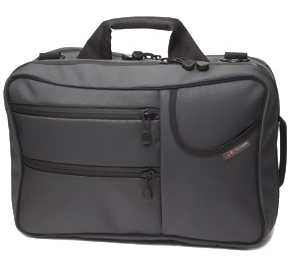In fact, to call it "just" a laptop bag would be a disservice; it's really an overnight bag. The Western Flyer has two main compartments of equal size. Each is about 3.5 inches deep. The front compartment has a vertical divider that zips out of the way if it's not wanted.
Either half of the divided front compartment can fit a pair of shoes (though you may want to first put your shoes in a Fabric/Fabric Packing Cube or a plastic bag -- more on the Packing Cubes in a moment) I don't use it for shoes, but it holds several small items of clothing just fine.
The front of the Western Flyer features three pockets. One is an open-top pocket for quick access to tickets, brochures, travel guides or letters. The other two pockets on the front of the Flyer zip close for security. The larger of the two pockets is big enough for most standard size paperback books. Both zippered pockets have o-rings (there are also more o-rings inside of the main compartments of the Western Flyer) for attaching Key Snaps and/or Clear, Padded, Cordura, or Cork Organizer Pouches.
The back compartment is large and undivided, and has annex clips that can either be removed or used to clip a Horizontal or Vertical Brain Cell laptop case inside of the Western Flyer. It sports buckles on the center wall that let you attach many of Tom Bihn’s Brain Cell computer sleeves. The Brain Cell isn’t as radical as its name would leave you to believe, but it’s a dependable “hard†case that integrates well with the Western Flyer. In fact, the Brain Cell is an interesting, unusual hybrid between a laptop case and a laptop sleeve -- and, as such, works well.
 But back to the Flyer's rear compartment: it has semi-rigid foam padding on the outside wall, when you're carrying the bag sling style. Which is just one way you can carry it.
But back to the Flyer's rear compartment: it has semi-rigid foam padding on the outside wall, when you're carrying the bag sling style. Which is just one way you can carry it.
Despite its myriad features and roominess, the Western Flyer isn't that bulky. It measures 18 x 12 x 7 inches and weighs just over two pounds (before you fill to the brim with your stuff, that is). And it's very flexible in the ways you can use it. With the long top side unzipped you can work out of the bag -- which comes in handy if you're, say, covering a Macworld Conference & Expo keynote.
The Western Flyer has one large padded handle directly above the center of gravity, plus two padded grab handles on the short ends to make it easy to, say, pull the bag out from the overhead compartment or from under a seat. There are two steel double-plated "D"-rings for attaching shoulder straps. The Western Flyer also converts a a backpack since the padded, contoured shoulder straps feature a removable/adjustable sternum strap and can be tucked away in their own compartment when not in use. Which method you'll wish to use to carry it will depend on how heavily you've packed the Western Flyer, how far you're going and how big a hurry you're in.
Tom Bin has designed three sizes of Packing Cube ($15-18) especially for the main compartments of the Western Flyer. The Packing Cubes Packing Cubes are designed to complement the Tom Bihn carry-on travel bags. The Packing Cubes can be used in multiple configurations. You can use two (stacked one on top of the other), or one plus two Small Packing Cubes. You can use four (stacked one on top of the other, or interlocking like bricks), or two plus one Large Packing Cube. One fills each end pocket, or four can fill the main compartment, like books on a shelf.
It's obvious that the Tom Bihn sweated the details on the Flyer. And the case is also one tough baby. The USA-made 1050 ballistic nylon has a nice stiffness, helps the bag hold its shape and is very durable. Also, the zippers are a gasketed waterproof-type.
The Western Flyer is overkill for those who just want something to -- for example -- carry their laptop to and from class. But for those frequently make longer trips, such as overnight jaunts, it's a fine, dependable traveling companion.

Macsimum rating: 9 out of 10.







 But back to the Flyer's rear compartment: it has semi-rigid foam padding on the outside wall, when you're carrying the bag sling style. Which is just one way you can carry it.
But back to the Flyer's rear compartment: it has semi-rigid foam padding on the outside wall, when you're carrying the bag sling style. Which is just one way you can carry it.








